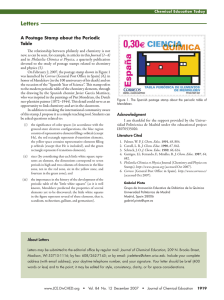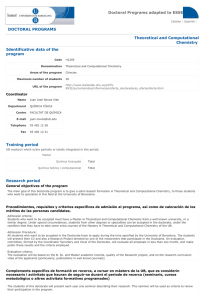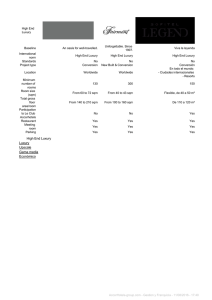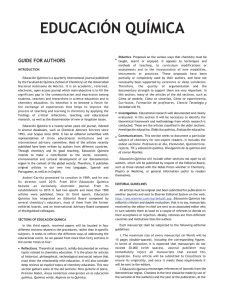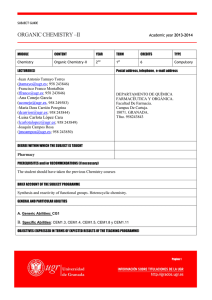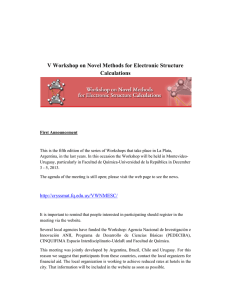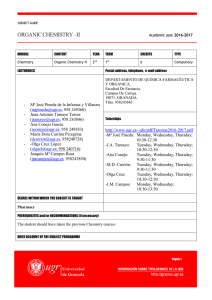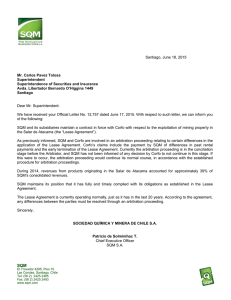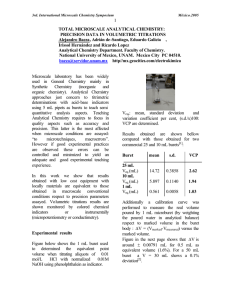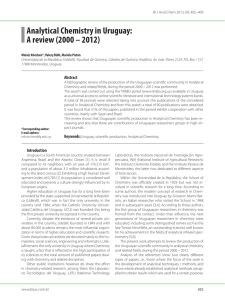0D-Semblanza 02-A.qxd - Journal of the Mexican Chemical Society
Anuncio
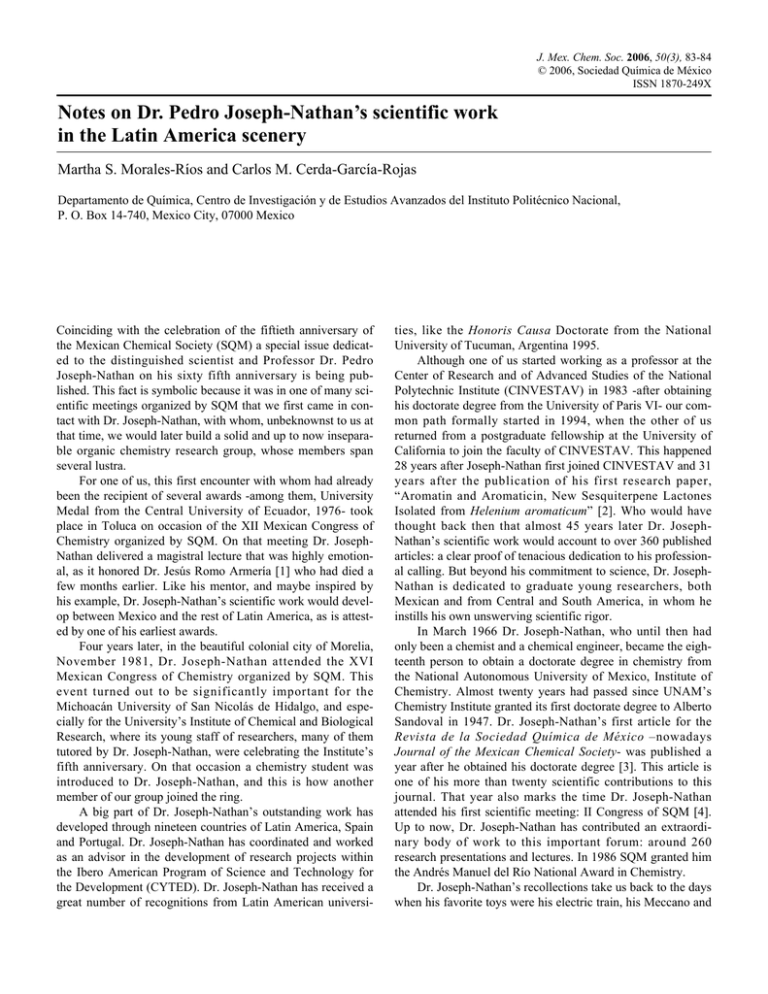
J. Mex. Chem. Soc. 2006, 50(3), 83-84 © 2006, Sociedad Química de México ISSN 1870-249X Notes on Dr. Pedro Joseph-Nathan’s scientific work in the Latin America scenery Martha S. Morales-Ríos and Carlos M. Cerda-García-Rojas Departamento de Química, Centro de Investigación y de Estudios Avanzados del Instituto Politécnico Nacional, P. O. Box 14-740, Mexico City, 07000 Mexico Coinciding with the celebration of the fiftieth anniversary of the Mexican Chemical Society (SQM) a special issue dedicated to the distinguished scientist and Professor Dr. Pedro Joseph-Nathan on his sixty fifth anniversary is being published. This fact is symbolic because it was in one of many scientific meetings organized by SQM that we first came in contact with Dr. Joseph-Nathan, with whom, unbeknownst to us at that time, we would later build a solid and up to now inseparable organic chemistry research group, whose members span several lustra. For one of us, this first encounter with whom had already been the recipient of several awards -among them, University Medal from the Central University of Ecuador, 1976- took place in Toluca on occasion of the XII Mexican Congress of Chemistry organized by SQM. On that meeting Dr. JosephNathan delivered a magistral lecture that was highly emotional, as it honored Dr. Jesús Romo Armería [1] who had died a few months earlier. Like his mentor, and maybe inspired by his example, Dr. Joseph-Nathan’s scientific work would develop between Mexico and the rest of Latin America, as is attested by one of his earliest awards. Four years later, in the beautiful colonial city of Morelia, November 1981, Dr. Joseph-Nathan attended the XVI Mexican Congress of Chemistry organized by SQM. This event turned out to be significantly important for the Michoacán University of San Nicolás de Hidalgo, and especially for the University’s Institute of Chemical and Biological Research, where its young staff of researchers, many of them tutored by Dr. Joseph-Nathan, were celebrating the Institute’s fifth anniversary. On that occasion a chemistry student was introduced to Dr. Joseph-Nathan, and this is how another member of our group joined the ring. A big part of Dr. Joseph-Nathan’s outstanding work has developed through nineteen countries of Latin America, Spain and Portugal. Dr. Joseph-Nathan has coordinated and worked as an advisor in the development of research projects within the Ibero American Program of Science and Technology for the Development (CYTED). Dr. Joseph-Nathan has received a great number of recognitions from Latin American universi- ties, like the Honoris Causa Doctorate from the National University of Tucuman, Argentina 1995. Although one of us started working as a professor at the Center of Research and of Advanced Studies of the National Polytechnic Institute (CINVESTAV) in 1983 -after obtaining his doctorate degree from the University of Paris VI- our common path formally started in 1994, when the other of us returned from a postgraduate fellowship at the University of California to join the faculty of CINVESTAV. This happened 28 years after Joseph-Nathan first joined CINVESTAV and 31 years after the publication of his first research paper, “Aromatin and Aromaticin, New Sesquiterpene Lactones Isolated from Helenium aromaticum” [2]. Who would have thought back then that almost 45 years later Dr. JosephNathan’s scientific work would account to over 360 published articles: a clear proof of tenacious dedication to his professional calling. But beyond his commitment to science, Dr. JosephNathan is dedicated to graduate young researchers, both Mexican and from Central and South America, in whom he instills his own unswerving scientific rigor. In March 1966 Dr. Joseph-Nathan, who until then had only been a chemist and a chemical engineer, became the eighteenth person to obtain a doctorate degree in chemistry from the National Autonomous University of Mexico, Institute of Chemistry. Almost twenty years had passed since UNAM’s Chemistry Institute granted its first doctorate degree to Alberto Sandoval in 1947. Dr. Joseph-Nathan’s first article for the Revista de la Sociedad Química de México –nowadays Journal of the Mexican Chemical Society- was published a year after he obtained his doctorate degree [3]. This article is one of his more than twenty scientific contributions to this journal. That year also marks the time Dr. Joseph-Nathan attended his first scientific meeting: II Congress of SQM [4]. Up to now, Dr. Joseph-Nathan has contributed an extraordinary body of work to this important forum: around 260 research presentations and lectures. In 1986 SQM granted him the Andrés Manuel del Río National Award in Chemistry. Dr. Joseph-Nathan’s recollections take us back to the days when his favorite toys were his electric train, his Meccano and 84 J. Mex. Chem. Soc. 2006, 50(3) his roller skates, with wheels that had to be replaced by new ones due to extreme wear. Those days also bring Dr. JosephNathan’s memories of renowned personalities from the chemistry world visiting his family home; celebrities like professor Albert Hofmann, who celebrated his one hundredth birthday last January 2006! [5], discoverer of the active principles of the Mexican magic mushrooms (“Teonanacatl”), and Professor Arthur Stoll (1887-1971) [6], a chemist and pharmacologist whose research work on ergot alkaloids made him worthy of worldwide prestige. Those familiar toys of old have now given way to watches and climatological measuring instruments. We now go back to 1941, the year when UNAM’s Institute of Chemistry was founded, coinciding with the 25th anniversary of the National School of Chemical Sciences of the same University [7]. It is in September of this emblematic year for the chemical science in Mexico that a blue, chubby rabbit shaped rattle welcomes a baby boy who would be named Pedro. His parents: Dr. Georg Joseph, who got his doctorate degree in pharmacy [8] from the University of Freiburg in Germany in 1926, and Alice Nathan whose mastery of the flute and piano [9] come from her time at the Conservatory of Berlin. When he celebrated his 24 birthday, the rising researcher had already coauthored several articles, 3 of which were published in one of the last volumes of the Bulletin of the Institute of Chemistry of the UNAM [10]. These articles clearly reflect what would be Dr. Joseph-Nathan’s favorite and therefore more frequent areas of research: natural products and nuclear magnetic resonance. As a conclusion, we must say that we feel exceptionally honored to have the enlightening experience of collaborating with Professor Emeritus Dr. Pedro Joseph-Nathan’s splendidly rich academic life (www.nathan.cinvestav.mx). The strings that have tied us for almost 25 years continue to strengthen our scientific bonds. Our best wishes for continued remarkably contribution to the progress of chemistry. Rosario Ruíz-Guerrero et al. References 1. Joseph-Nathan, P. En homenaje al Dr. Jesús Romo Armería, Rev. Soc. Quím. Méx. 1977, 21, 127-127; 281-299. 2. Romo, J.; Joseph-Nathan, P.; Díaz. F. Aromatin and aromaticin, new sesquiterpene lactones isolated from Helenium aromaticum, Chem. Ind. 1963, 1839-1839. 3. Manjarrez, A.; Foster, L; Joseph-Nathan, P. Diagramas de equilibrio II. Espectroscopía de resonancia magnética nuclear para el estudio del equilibrio del sistema p-dioxano-agua, Rev. Soc. Quím. Méx. 1967, 11, 171-174. 4. Manjarrez, A.; Foster, L.; Joseph-Nathan, P. Equilibrio del sistema agua-1,4-dioxano por RMN, II Congreso Mexicano de Química Pura y Aplicada, Monterrey, N. L. Rev. Soc. Quím. Méx., 1967, 11, 96-96. 5. (a) Amato, I. Trip of a century, Albert Hofmann, inventor of the mind-altering drug LSD, celebrates his 100th birthday, Chem. Eng. News, 2006, 43-44. (b) Kubelka, W.; Bauer, R. Albert Hofmann an event of the century!, Planta Med. 2006, 72, 97-98. 6. Festschrift Prof. Dr. Arthur Stoll, Benno Schwabe & CO Verlag, Basel, 8, Switzerland, January 1947. 7.García Fernández, H. Historia de una facultad, química 1916-1983, Universidad Nacional Autónoma de México, Ciudad Universitaria, D. F., 1985, 136-138. 8. (a) Lecher, H.; Joseph, G. Über das Chlorrhodan von Kaufmann und Liepe, Ber. Dtsch. Chem. Ges. 1926, 59, 2603-2606. (b) Joseph, G. Versuche zur Darstellung von Imiden aliphatischer Sulfensäuren, Inaugural-Dissertation, Albert-LudwigsUniversität Freiburg Im Breisgau, Dekan: Professor Dr. F. Oltmanns, Referent: Professor Dr. H. Staudinger, Freiburg, Germany, December 1926. 9. Alicia N. de Joseph, Sistema mejorado para enseñanza musical, Patente de mejoras número 113177, Secretaría de Industria y Comercio, Mexico, February 29, 1972. 10. (a) Walls, F.; Salmón, M.; Padilla, J.; Joseph-Nathan, P.; Romo, J. La estructura de la perezona, Bol. Inst. Quím. Univ. Nal. Autón. Méx. 1965, 17, 3-15, (b) Díaz, E.; Joseph-Nathan, P.; Romo de Vivar, A.; Romo, J. Análisis mediante resonancia magnética nuclear I. Determinación de estructuras de lactonas azulogénicas, Bol. Inst. Quím. Univ. Nal. Autón. 1965, Méx. 17, 122-138. (c) Díaz, E.; Joseph-Nathan, P.; Romo, J. Análisis mediante resonancia magnética nuclear II. Determinación de estructuras de furotetralinas, Bol. Inst. Quím. Univ. Nal. Autón. Méx., 1965, 17, 139-150.
